Podcast
Questions and Answers
Which characteristic primarily distinguishes a developing nation from a developed nation?
Which characteristic primarily distinguishes a developing nation from a developed nation?
- Predominance of suburban settlements over urban centers.
- Greater focus on agricultural exports.
- Lower population density in rural areas.
- Higher levels of industrialization and modernization. (correct)
How does 'situation' contribute to understanding a city's importance?
How does 'situation' contribute to understanding a city's importance?
- By measuring the city's population density and demographic makeup.
- By outlining the historical events that shaped the city's development.
- By detailing the specific physical features of the city's location.
- By describing the city's location relative to other significant places or features. (correct)
What is a key difference between a topographic map and a standard road map?
What is a key difference between a topographic map and a standard road map?
- A topographic map is used for urban planning, while a road map is for rural navigation.
- A topographic map uses an alphanumeric grid system, while a road map does not.
- A topographic map shows political boundaries, while a road map focuses on physical features.
- A topographic map provides detailed physical and contour lines, while a road map focuses on transportation routes. (correct)
Which of the following best describes the concept of 'land use'?
Which of the following best describes the concept of 'land use'?
How does a 'strategic site' typically influence urban development?
How does a 'strategic site' typically influence urban development?
What is a defining characteristic of a 'megalopolis'?
What is a defining characteristic of a 'megalopolis'?
Which factor primarily contributes to the growth of suburban settlements?
Which factor primarily contributes to the growth of suburban settlements?
What is the main purpose of using an alphanumeric grid on a map?
What is the main purpose of using an alphanumeric grid on a map?
How does a harbour site influence the development of a city?
How does a harbour site influence the development of a city?
Which scenario exemplifies the process of urbanization?
Which scenario exemplifies the process of urbanization?
Why were strategic settlement sites often built next to water or on elevated ground?
Why were strategic settlement sites often built next to water or on elevated ground?
Which of the following best describes the relationship between natural resource sites and community development?
Which of the following best describes the relationship between natural resource sites and community development?
In addition to waterways, what other type of location commonly serves as a meeting point site for city development?
In addition to waterways, what other type of location commonly serves as a meeting point site for city development?
What is the primary advantage of Hamilton's harbour site for its economic activities?
What is the primary advantage of Hamilton's harbour site for its economic activities?
What is the key difference between absolute and relative location?
What is the key difference between absolute and relative location?
How do alphanumeric grids and latitude/longitude systems relate in terms of specifying a place?
How do alphanumeric grids and latitude/longitude systems relate in terms of specifying a place?
What type of information is primarily conveyed through the use of contour lines on a topographic map?
What type of information is primarily conveyed through the use of contour lines on a topographic map?
Considering Hamilton's geographic characteristics, which of the following industries would MOST benefit from its location?
Considering Hamilton's geographic characteristics, which of the following industries would MOST benefit from its location?
In what way do strategic sites and natural resource sites differ in their primary function?
In what way do strategic sites and natural resource sites differ in their primary function?
If a city is described as being 'south of the river and west of the mountains,' what type of location is being described?
If a city is described as being 'south of the river and west of the mountains,' what type of location is being described?
How does the concept of 'situation' enhance the understanding of a city's growth potential?
How does the concept of 'situation' enhance the understanding of a city's growth potential?
What factors differentiate a developed nation from a developing nation?
What factors differentiate a developed nation from a developing nation?
How does urbanization impact rural areas?
How does urbanization impact rural areas?
What is a primary advantage of using an alphanumeric grid system for mapping?
What is a primary advantage of using an alphanumeric grid system for mapping?
In what way does a 'strategic site' play a crucial role in the historical development of urban areas?
In what way does a 'strategic site' play a crucial role in the historical development of urban areas?
What is the MOST important implication of a location being classified as a 'natural resource site'?
What is the MOST important implication of a location being classified as a 'natural resource site'?
How does the physical 'site' of a city directly influence its development?
How does the physical 'site' of a city directly influence its development?
What characteristic defines a 'megalopolis'?
What characteristic defines a 'megalopolis'?
Which of the following is MOST crucial to the emergence of suburban settlements?
Which of the following is MOST crucial to the emergence of suburban settlements?
What advantage does a harbour site offer regarding economic activity?
What advantage does a harbour site offer regarding economic activity?
How do strategic sites primarily benefit settlements during conflicts?
How do strategic sites primarily benefit settlements during conflicts?
Why are 'meeting point sites' along waterways considered advantageous for city development?
Why are 'meeting point sites' along waterways considered advantageous for city development?
In what way does the presence of steel factories along Hamilton's harbour specifically demonstrate the advantages of its site?
In what way does the presence of steel factories along Hamilton's harbour specifically demonstrate the advantages of its site?
How does using latitude and longitude to determine location differ from using an alphanumeric grid?
How does using latitude and longitude to determine location differ from using an alphanumeric grid?
How do topographic maps enhance urban planning compared to standard road maps?
How do topographic maps enhance urban planning compared to standard road maps?
What is an example of a location exhibiting characteristics of both a 'natural resource site' and a 'meeting point site'?
What is an example of a location exhibiting characteristics of both a 'natural resource site' and a 'meeting point site'?
Which of the following scenarios best demonstrates the practical application of relative location?
Which of the following scenarios best demonstrates the practical application of relative location?
Why was access to bodies of water strategically important in the development of 'strategic sites'?
Why was access to bodies of water strategically important in the development of 'strategic sites'?
What distinguishes a 'natural resource site' from other types of settlement sites?
What distinguishes a 'natural resource site' from other types of settlement sites?
Considering the factors influencing settlement patterns, what is a key reason for communities developing at 'meeting point sites'?
Considering the factors influencing settlement patterns, what is a key reason for communities developing at 'meeting point sites'?
Flashcards
Developing Nation
Developing Nation
A country with a lower standard of living and less access to goods and services than developed nations.
Megalopolis
Megalopolis
An urban area with over 50 million people, like Bosnywash (Boston, New York, Washington).
Land Use
Land Use
The purpose for which people use a particular area.
Strategic Site
Strategic Site
Signup and view all the flashcards
Urbanization
Urbanization
Signup and view all the flashcards
Situation
Situation
Signup and view all the flashcards
Topographic Map
Topographic Map
Signup and view all the flashcards
Developed Nation
Developed Nation
Signup and view all the flashcards
Suburban Settlement
Suburban Settlement
Signup and view all the flashcards
Alphanumeric Grid
Alphanumeric Grid
Signup and view all the flashcards
Harbour Site
Harbour Site
Signup and view all the flashcards
Natural Resource Site
Natural Resource Site
Signup and view all the flashcards
Meeting Point Site
Meeting Point Site
Signup and view all the flashcards
Absolute Location
Absolute Location
Signup and view all the flashcards
Relative Location
Relative Location
Signup and view all the flashcards
Compass Rose
Compass Rose
Signup and view all the flashcards
Latitude vs Longitude
Latitude vs Longitude
Signup and view all the flashcards
Latitude
Latitude
Signup and view all the flashcards
Longitude
Longitude
Signup and view all the flashcards
Rural Settlement
Rural Settlement
Signup and view all the flashcards
Urban Settlement
Urban Settlement
Signup and view all the flashcards
Population Shift
Population Shift
Signup and view all the flashcards
Megalopolis Example
Megalopolis Example
Signup and view all the flashcards
Land Use Purpose
Land Use Purpose
Signup and view all the flashcards
Topographic Map Features
Topographic Map Features
Signup and view all the flashcards
Study Notes
Developing Nations vs Developed Nations
- Developing Nation: A country where most people have a lower standard of living and less access to goods and services compared to people in developed nations.
- Developed Nation: A country with a higher level of income, industrialization, and modernization. Often have larger urban populations.
Megalopolis
- Megalopolis: An urban area with over 50 million people.
- Example: Bosnywash (Boston, New York, Washington D.C.).
Land Use and Strategic Sites
- Land Use: The purpose for which people use a particular area.
- Strategic Site: Places providing protection and control over territory; often elevated land overlooking key routes.
Urbanization and Rural Settlements
- Urbanization: The increase of urban areas, usually the spread of cities and large communities into rural areas.
- Rural Settlement: Areas with fewer than 1000 people, including farms and communities. Many are found in developing nations. People often farm and fish for food.
- Urban Settlement: Communities with 1000 or more people living close together. 80% of Canadians live in urban areas. Urbanization has been a major shift in human geography since 1950, when only ~25% of the world's population was urban.
- Larger rural populations often exist within developing nations.
Types of Settlements and Locations
- Site: The specific physical features defining the location of a place.
- Situation: The location of a place in relation to other places or larger features.
- Natural Resources Site: Settlements develop near resources like mines or waterfalls, allowing for the acquisition and processing of resources.
- Harbour Site: Cities develop near harbors for protection, docking, and trade. Harbors are vital for loading and unloading resources.
- Meeting Point Site: Settlements develop at crossroads or along waterways for ease of communication and trade.
- Strategic Site: Settlements often constructed near water or on elevated positions for defense and control, vital during conflict.
Location Systems
- Absolute Location: Determined using alphanumeric grids, latitude, and longitude.
- Relative Location: The position of a place in relation to another location.
- Alphanumeric Grid: An interlocking system of letters and numbers for locating places (similar to a game board).
- Latitude: Measured in degrees north and south of the equator.
- Longitude: Measured in degrees east and west of the prime meridian.
Topographic Maps
- Topographic Map: A very detailed map showing physical and human features via contour lines and other symbols.
Suburban Settlements
- Suburban Settlements: Newer communities located at the edges of established cities.
Examples: Hamilton, Canada
- Hamilton's Site: Built on a harbor site, facilitating good transportation of goods (e.g. steel factories).
Other Concepts (from the provided text)
- Rural: Sparsely settled areas.
- Alphanumeric Grid: A system of interlocking letters and numbers for determining location, similar to a game board.
Studying That Suits You
Use AI to generate personalized quizzes and flashcards to suit your learning preferences.




